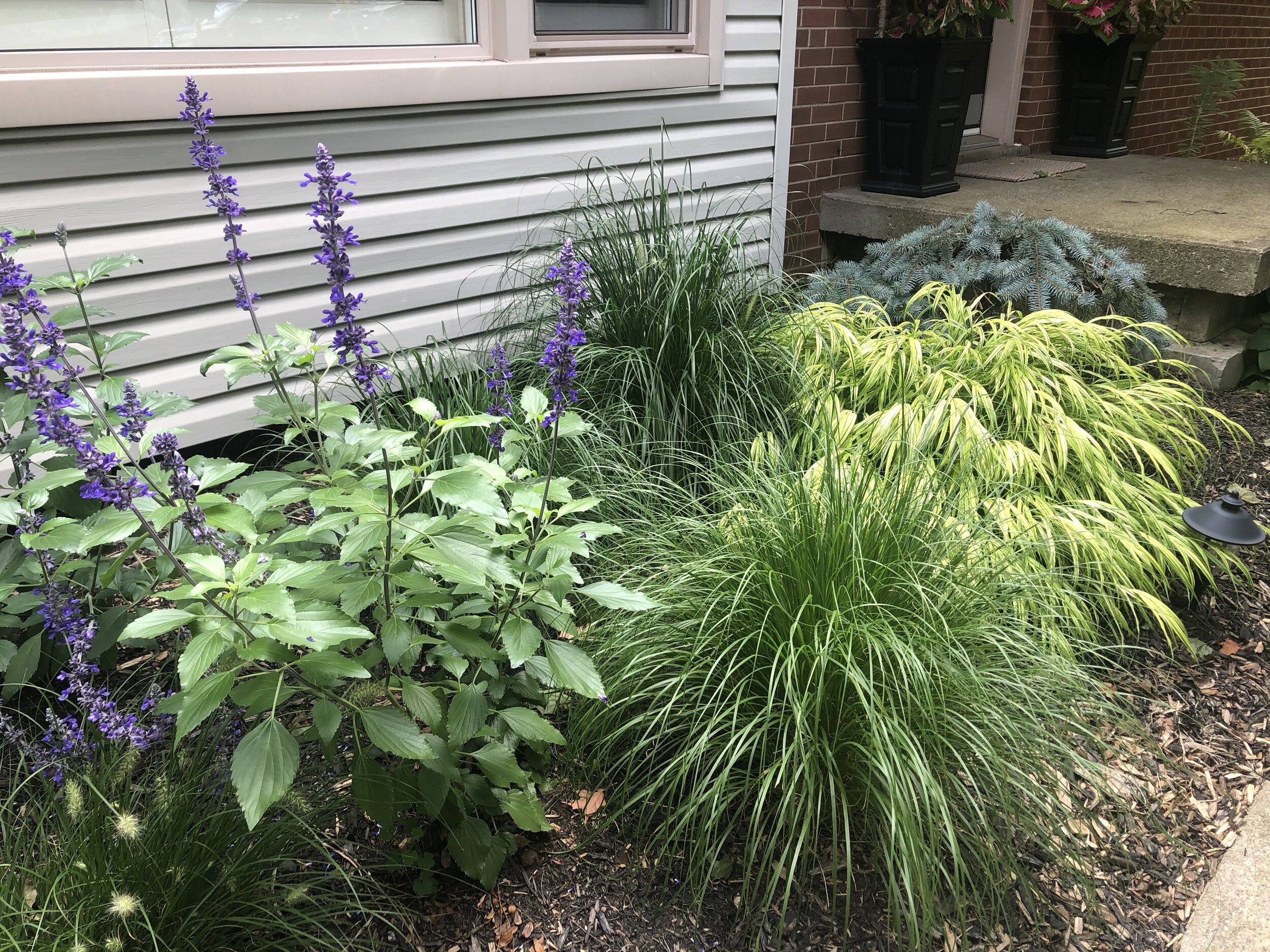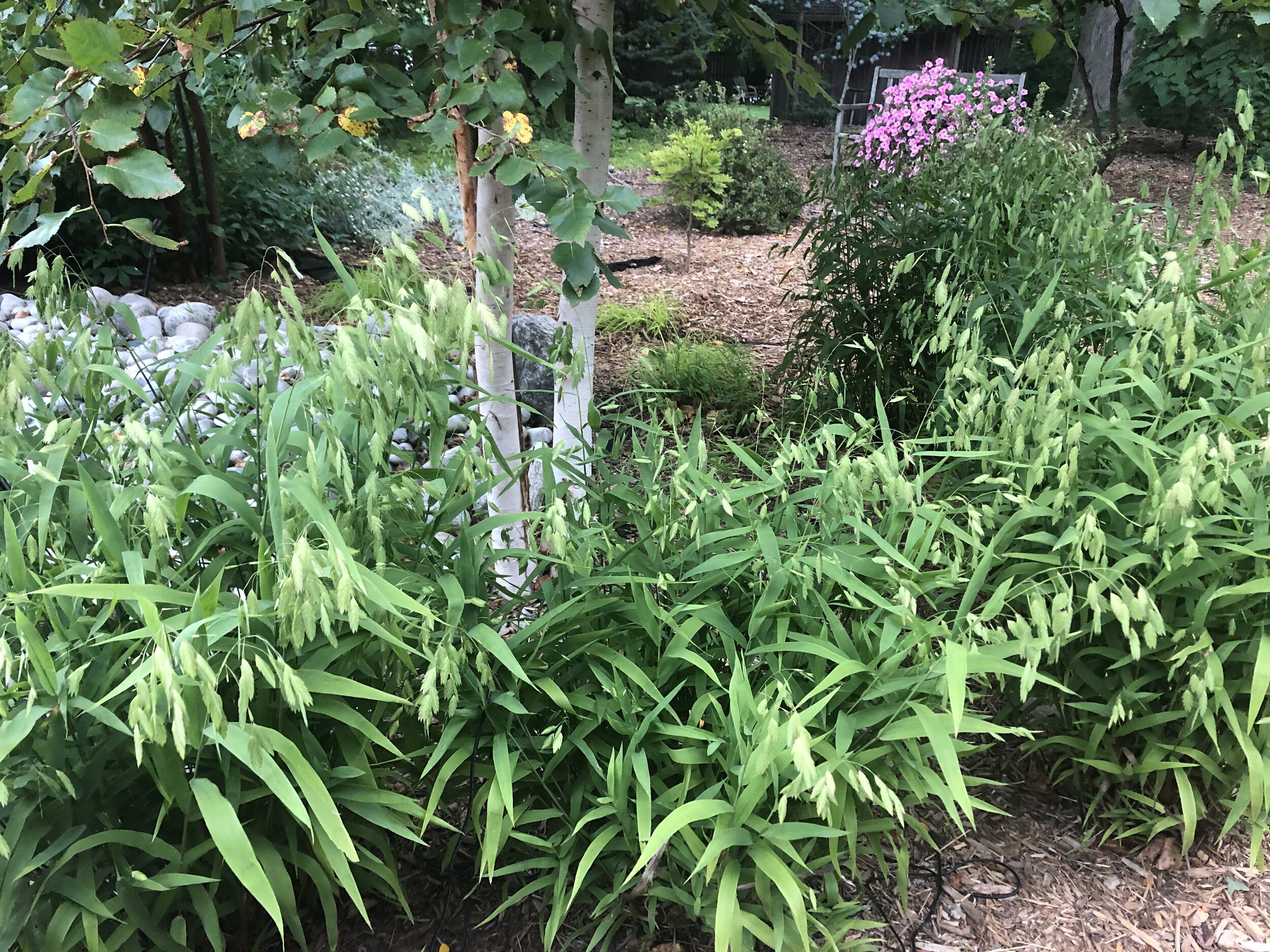Three of the best ornamental grasses for sun and shade
Japanese Forest Grass All Gold is a real winner
Nothing welcomes Fall like a beautiful late summer grass, its blooms gently blowing in the wind.
The popularity of grasses probably first set root in Wolfang Oehme and James van Sweden’s revolutionary landscape designs in the New American Garden, some 40-plus years ago. The landscape architects’ style very much celebrated the inherent textures and beauty in the tapestry of a North American meadow. At the same time, the landscape design recognized the inherent ecological, sustainable, aesthetic, and ornamental value of using grasses interlaced with a couple of strong flowering four-season performers. It was not enough for their garden designs to look good in the traditional gardening seasons, they had to be interesting in all four seasons.
Grasses, of course, play a key role in this four-season approach looking as good, if not better, in the fall and winter after the stalks dry and turn a lovely golden colour. An added bonus is the grass heads often catching the falling snow in the dead of winter.
The landscape designers’ approach focused on expansive gardens where huge swaths of ornamental grass was mass planted alongside swaths of Black-eyed Susans or Sedum Autumn Joy.
The success of the New American Garden design began to inspire more urban gardeners to consider ornamental grasses as an architectural element in their smaller, city front and back gardens. Today, it’s hard to walk through a typical neighbourhood without seeing several examples of ornamental grasses being used.
• Looking for some ideas for low-growing ornamental grasses? Be sure to check out my post on Five low-growing ornamental grasses.
Hakonechloa aurelia (Japanese Forest Grass) is an outstanding warm-summer grass that is one of the few grasses that thrives in full shade, making it perfect for the woodland garden.
If you are a little late getting in on the ornamental grass revolution, here are three very different examples I use that might be of interest to you.
Miscanthus Sinensis forms an elegant clump in our front garden.
Miscanthus Sinensis Gracillimus or Maiden Grass is certainly one of the most popular choices of this graceful upright mounding grass that stands about 4 feet high with a flowering height of an additional two feet. I use it both in the front and back gardens. In the front it acts as the perfect border to create a soft, elegant privacy screen between us and our neighbour’s driveway. Just enough to soften the hardscape, but not to much that we block one another out from a friendly conversation. In the back, two specimens stand guard on each side of a dry river bed helping to soften the edges and add some mystery to the dry-river bed.
Also known as Japanese Silver Grass, this long-lived plant (approximately 20 years) certainly stands the four-season test remaining attractive from summer through winter as it slowly changes to its light tan winter coat. The grass is native to China, Japan, South Korea and Taiwan.
The grass’s dainty plumes of pink flowers rising above the foliage from late summer into early fall, give way to violet-coloured seed heads.
Like most grasses, it’s best to leave it until spring before cutting it down. The tan grasses are too important in the winter landscape. Birds will also use the strong stalks during the winter as perching spots. The dried grasses also help to gather snow around the plant’s base providing shelter for small rodents and insects to help them overwinter in the garden.
The plant does best in full sun to partial shade and prefers moist conditions. It does well in most soil types and is highly tolerant of urban pollution making it an ideal addition to an urban environment.
Because it is not native to North America, it may be subject to certain restrictions or prohibitions on propagation.
Japanese Forest grass sits in our front border alongside a prostrate blue spruce, fountain grass and blue salvia.
Hakonechloa (Japanese Forest Grass) is an outstanding, warm season grass that adds a hit of glorious colour to shady areas of the garden.
All Gold Japanese Forest Grass is a great choice
Of particular interest is the All Gold Japanese Forest Grass (zones 5-9) that is an outstanding performer in the landscape especially when it comes into its own in late summer into early fall.
Grow it in rich, loamy soil because these grasses do not toleratepoorly drained soils that often come along with clay soils. Japanese Forest Grass All Gold also does not tolerate very dry soils. In colder climates such as zones 5-6, it’s a good idea to mulch the area with fall leaves which can be removed in spring when you cut back the foliage.
All gold like an acidic to neutral soil. Consider using Hakonechloa “All Gold” as a border plant, in containers as a spiller, or as an edging plant, in a mass planting or as a specimen plant.
Unlike the previous grass, Hakonechloa enjoys full shade where its graceful arching form lends a softness and elegance to the landscape and its yellow and green leaves are given the opportunity to really shine. It can handle part shade but will struggle to show its best colours in full sun. It’s one of the few grasses that prefers full shade and that’s reason enough to love the plant.
It never gets too high so it also works well in the front or middle of a large border. It’s also completely at home as a specimen plant all on it’s own. It is native to eastern Asia.
In our garden, Japanese Forest Grass is used primarily in the front Japanese-inspired garden where clumps of it are working to surround the front of a large Japanese Maple. Another large clump is used to soften the front porch foundation and yet more is being grown to eventually surround a small birdbath.
Japanese Forest grass, either the variegated form or the even more beautiful all-gold variety, are at home as a focal point in the woodland or tucked away in a corner to lighten up a dark area of the garden. I have seen outstanding examples of mass plantings around Japanese maples in front gardens that literally take your breath away.
These grasses are well behaved. Their dense mounds of short wide variegated blades emerge from stems in the centre of the mound and slowly spread out into large mounds that can be split to create new plants. The yellow and green leaves turn red and purple shades in the fall before turning to the familiar winter tan colour where they continue to provide interest throughout the winter.
If you are new to these grasses, don’t be surprised in the spring if you don’t see a lot of early growth. They are warm season grassed and don’t begin throwing new growth until the ground heats up in early to midsummer. Keep them well watered for best performance but they can tolerate heat and drought once they are well established.
An example of a clump of Northern Sea Oats surrounding our three birch clumps. The North American native, grown primarily for its seed heads, can easily spread if left unchecked.
Northern Sea Oats (Chasmanthium latifolium) is grown not for it’s grasses but its lovely drooping hop-like seed heads that emerge in late summer and remain on the plant through the winter. The seed heads delicately cling to the grasses and flutter in the wind adding lovely movement to the landscape.
Unfortunately, what makes this plant so sought after is also its downfall. These beautiful seed heads are known to fall to the ground and happily emerge in the spring as new plants. Now, this is great if want more and more of this North American native grass (Central and northeast United States) in your garden, but be aware before you plant it that it does have a tendency to spread. I grow ours in a heavily mulched area, so keeping it under control is not a huge task.
It’s grassy leaves are light green but turn a gorgeous coppery-bronze in the fall. This is another grass that is best cleaned up in the spring, but if you want to keep the seeds in check, feel free to gather as many of them in fall before they drop to the ground.
Northern Sea Oats grows to about 4 feet tall with a spread of about 30 inches. Its foliage extends to the base of the plant allowing it to stand alone in the landscape and you can expect a good ten years out of the plant. It’s deer resistant, makes an excellent cut flower for a fall arrangement, and it makes a good container plant that can even work as an effective thriller in a container or window box.
This tough grass prefers full sun but does well in part sun.
• This page contains affiliate links. If you purchase a product through one of them, I will receive a commission (at no additional cost to you) I try to only endorse products I have either used, have complete confidence in, or have experience with the manufacturer. Thank you for your support.




